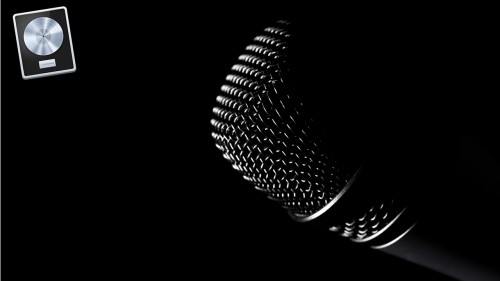- Covers Logic 10.2-10.3
- Create Killer Guitar & Bass Tracks
- Work with Patches to Fatten Your Tracks
- Apply Amps and Pedal Boards
- Fix Timing with Logic’s Groove Track
- Mix and Bounce Your Songs
Guitars & Bass in Logic Pro X
$29.00
Play with a Real Drummer
Recording to a click track is a simple way to help you maintain the right tempo, but it often feels empty and uninspired. Instead you can quickly create a virtual drummer to help you get a feel for the energy of your next big hit, and we’ll show you how.
Find the Perfect Guitar Player
Do you need a theme song for your YouTube channel? Maybe a rockin’ guitar track for your next short film? This tutorial will show you how to can create it in a snap, even if you’ve never picked up a guitar.
Logic Pro X to the Rescue
If you’re having an off day in the studio, it doesn’t mean that the project is ruined. In this tutorial, you’ll learn how to use Logic’s powerful tools for correcting pitch, tempo, timing, and just about anything else that can go wrong.
Create Wah-Some Tracks
Logic Pro X has a multitude of virtual DI Boxes, Wah Pedals, Compressors, and other effects. In this tutorial you’ll learn how to add these effects to your recording and tune them to your needs. Making it easier than ever to experiment with a new style or sound.
Guitars and Bass in Logic Pro X
1. Setting up a Guitar Project
- Creating a New Project
- The Streamlined UI
- Enabling the Advanced UI
- Adding a Stereo Track
- Choosing an Audio Source
- Adding an Audio Track for Guitar Recording
- Audio Interfaces
- Identifying Track Types
- Adjusting Track Size
- Inspector Options for Tracks
- Choosing a Tempo
- Recording at the Native Tempo
- Using the Metronome
- Reducing the Tempo
- Adding a Drum as a Click Track
- Tuning Your Guitar
- Changing the Key
2. Arranging with Guitar Loops
- Exploring the Loop Browser
- Types of Guitar Loops
- How Loops Accommodate Tempo & Key
- Importing the Loop Tempo Change
- Deleting Tracks
- Guitar Loop Families
- Setting Original Key Playback
- Changing the Project Key
- Creating Tracks from a Family of Loops
- Looking for a Song Intro
- Arranging & Extending Loops
- Slicing & Duplicating Loops
- Playing Back Mary’s Final Version
3. Working with Templates
- Setting the Project Details
- Tap Tempo
- Songwriter Template Breakdown
- Saving a Template
- Opening a Custom Template
4. Recording a Guitar – Part 1
- Track Record Enable
- Recording to Multiple Tracks
- Arming a Track
- Record Button States
- Where Recording Begins
- Reviewing the Notepad
- Choosing a Recording Method
- On the Fly Recording
- Overlapping Recording
- Punch-In Recording
- Multiple Tracks Recording
- Setting up Tap Tempo
- Setting a Custom Key Command
- Assigning a Shortcut for Tap Tempo
- Using Tap Tempo
5. Recording a Guitar – Part 2
- Recording on the Fly
- Choosing a Count In Option
- Input Monitoring
- Making Timing Adjustments
- Trimming to a Measure for Looping
- Setting a Cycle Region
- Setting up an Overlapping Recording
- Choosing a Cycle Option
- Working with Takes
- Choosing the Best Take Performance
- Playing Back the Comp
- Editing Options for Comps
- Editing a Comp
- Introduction to Punch-In Recording
6. Punch-In Recordings
- 2 Types of Punch-In Recording
- Customizing the Control Bar
- Adding Punch-In Mode Buttons
- How the In & Out Buttons Work
- Performing a Single Take Punch-In
- On the Fly Punch Ins
- Replacing a Take During a Punch-In
- Quick Punch-Ins
- Record Button States
- Record/Record Toggle
- Record/Record Repeat
7. Fattening a Rhythm & Lead Guitar
- Opening a GarageBand Project
- Opening a GarageBand Project in Logic
- Track Breakdown
- Soloing the Rhythm Guitar Track
- Fattening the Guitar Track
- Panning the Guitar
- Changing the Guitar Patch
- Auditioning Guitar Patches
- Playing Back the Fattened Rhythm Guitar
- Splitting the Lead Guitar
- Creating a Lead Guitar Stomp Box Sound
- Auditioning Alternate Lead Guitar Patches
8. Working with Amps & Pedalboards
- Working with Smart Controls
- The Amp & Pedalboard Controls
- Working in the Amp Designer
- Adding Reverb
- Exploring Reverb Flavors
- Applying Amp Presets
- Comparing Amp Sounds
- Changing the Amp Model
- Changing the Amp Type
- Changing the Amp Cabinet
- Changing the Mic & Placement
- Working with the Pedalboard
- Auditioning Pedalboard Sounds
- Auditioning a Wah Pedal
9. Working with a Groove Track
- The Terrible Timing Problem
- Aligning the First Note
- Enabling the Magical Groove Track
- Configuring the Track Header
- Setting the Lead Track
- Instant Timing Fixes
- How the Groove Track Works
10. Altering Time with Flex
- Working with the Bass Track
- Enabling Flex
- Editing the Track Non-Destructively
- The Flex Button in the Track Editor
- How Flex Time Works
- Using Flex Time to Modify Timing
- Flex Options
- Using Monophonic Flex Time
- Change the Position of Notes
- Adding Transients
- Why Set Transients
- Editing the Transients
11. Altering Pitch with Flex
- How Flex Pitch Works
- Enabling Flex Pitch
- Analyzing the Flex Curve
- Adjusting Pitch Drift
- Adjusting Gain
- Adjusting Fine Pitch
- Pitch Adjusting Multiple Notes
- Adjusting Vibrato
12. Transposing a Track
- Locating Transpose in the Inspector
- Transposing by Octave
- Changing the Instrument
- Panning the Tracks
13. Working with MIDI Guitars & Bass
- The Piano Roll Editor
- The Score Editor
- The Step Editor
- Expanding the Editor
- Creating a Bass Part
- Collapsing the View
- Adding a MIDI Bass Track
- Recording a Bass Track on the Fly
- How to Find a Note with Flex Pitch
- Borrowing Notes from Another MIDI Loop
- Turning a Guitar into a Bass
- Characteristics of the Fretless Bass
- Raising the Velocity of the Bass Notes
14. Adding Bass Effects
- Bouncing Out the Bass Track
- Applying an Effect to the Bounced Bass Track
15. Introduction to Song Mixing
- Mixing is Like Cooking
- What You Should be Listening For
- Listening for Bass in the Unmixed Project
- Listening for Bass in the Mixed Version
- Comparing 2 Mixes
- Reviewing the Project Notes
- Mixing Steps
- Foundation Tracks
- Lead Tracks
- Backing & Background Tracks
- A Note about Mixing Styles
- Frequency Masking Explained
- 2 Common Ways of Mixing
- How Your System Affects Your Mixing Choice
16. Balancing Your Guitar Tracks
- Isolating Individual Tracks
- Identifying the “Hero” Track
- Where’s my Bass?
- Soloing the Guitars
- Separating the Rhythm Guitar by Duplicating & Panning
- Reviewing the Mixing Steps
- Comparing Tracks During Playback
- Giving the Lead Guitar a Live Room Feel
- Improving the Stereo Spread
- Moving an Effect from One Channel to Another
17. Adding Effects to the Mix
- Adding a Pedalboard to the Lead Guitar
- How the Pedalboard Affects the Mix
- Adding a Delay & Echo
- Running the Effect Through the Mixer
- Working with the High Drive Pedal
18. DI Boxes & Compressors
- Hi-Fi DI
- The DI Box
- What DI Boxes Do
- Adding Bass EQ
- Dealing with Peaking
- Compressing the Bass
- Adding a Compressor Preset
- Adjusting the Ratio
- Adjusting the Threshold
19. Working with the Channel EQ
- EQ the Bass
- Enabling the Analyzer
- Adding an EQ Preset
- Scooping the Frequencies
- Adjusting Q (Bandwidth)
- Boosting Frequencies
- Fundamental Frequencies
- Harmonic Frequencies
- EQ the Rhythm Guitar
- EQ the Lead Guitar
20. Mixing the Drum Kit
- Accessing the Kit Mics
- Opening the Track Stack
- Crafting the Sound of the Kit
21. Mixing Automation Part 1
- Creating a Track Stack
- Creating a Summing Stack
- Adding an Effect to the Summing Stack
- Renaming the Summing Submix
- Adding a Wah Pedal
- Monitoring Levels with the Level Meter
- Automation Explained
- Revealing Automation Controls
- Adding a Volume Curve
- Creating a Fade Curve
22. Mixing Automation Part 2
- Automating an Effect (Wah Pedal)
- Adding Automation Tracks
- Automating the Pedal State
- Automating the Pedal Position
- Changing the Bypass Point
23. Mastering & Output
- Working with the Master Track
- Reasons to Use a Master Track
- Revealing Mastering Effects
- Applying Mastering Presets
- Outputting the Project
- Minding Your End of Song Marker
- Outputting Tracks or a Mix
- Choosing a Format
- Normalizing the Output
- Tightening up the Bounced Section
- Sharing Your Mix
- Exporting Options
- Exporting Stems
- Creating a Rehearsal Tape
- Saving Conventions
- Saving as a Folder
Who this Tutorial is for:
This tutorial was designed for songwriters, musicians, video editors, producers and content creators who want to create great sounding guitar and bass tracks for their projects.
This tutorial assumes basic familiarity with Logic Pro X. Software Version: Logic Pro 10.2 - Logic Pro 10.3.
Run Time: 3 Hours 20 minutes
Project Media Included: The tutorial includes media files for following along in Logic Pro X.
Type of Tutorial: Project Specific
About the Author: Mary Plummer
1 review for Guitars & Bass in Logic Pro X
Related products
-
 Page load link
Page load linkWarp Speed Logic: Scoring to Picture
In this training course, you will learn the basics of music scoring using Apple's Logic Pro. You'll work with loops and virtual instruments to arrange your song to picture, then mix and deliver a finished master. This tutorial is perfect for the Final Cut Pro user.Rated 5.00 out of 5$29.00
Working with Dialogue & Voice in Logic Pro X
An indispensable tutorial that focuses on recording, editing and mixing dialogue, voiceover, narration and song vocals.Rated 4.57 out of 5$29.00
Music Scoring for Video in Logic Pro X
Unleash your inner John Williams by showing you the secrets of creating evocative scores and soundscapes for your films or videos using Logic’s powerful Synth and Percussion instruments.Rated 4.33 out of 5$29.00[]We use cookies to enable the site's core functionalities. Please review our cookie policies in the Privacy Policy. Details OK, I understandFirst Party Cookies
These cookies are required for the site to perform its core functionalities. This includes cookies allowing you to securely log-in and log-out and make an order through our online shop.Third Party Embeds
These are cookies needed to optimize your experience on our website. This includes analytics cookies, cookies to run 3rd party services like videos, etc.Go to Top

Diane C. (verified owner) –
I can’t say enough about how much I have enjoyed this tutorial and all Mary Plummer’s Logic Pro tutorials. Because of the tutorials, I now understand what Logic Pro can do and how it works. I’m not struggling with the application interface. With Mary Plummer’s tutorials, I have a whole new skill set. Many thanks.